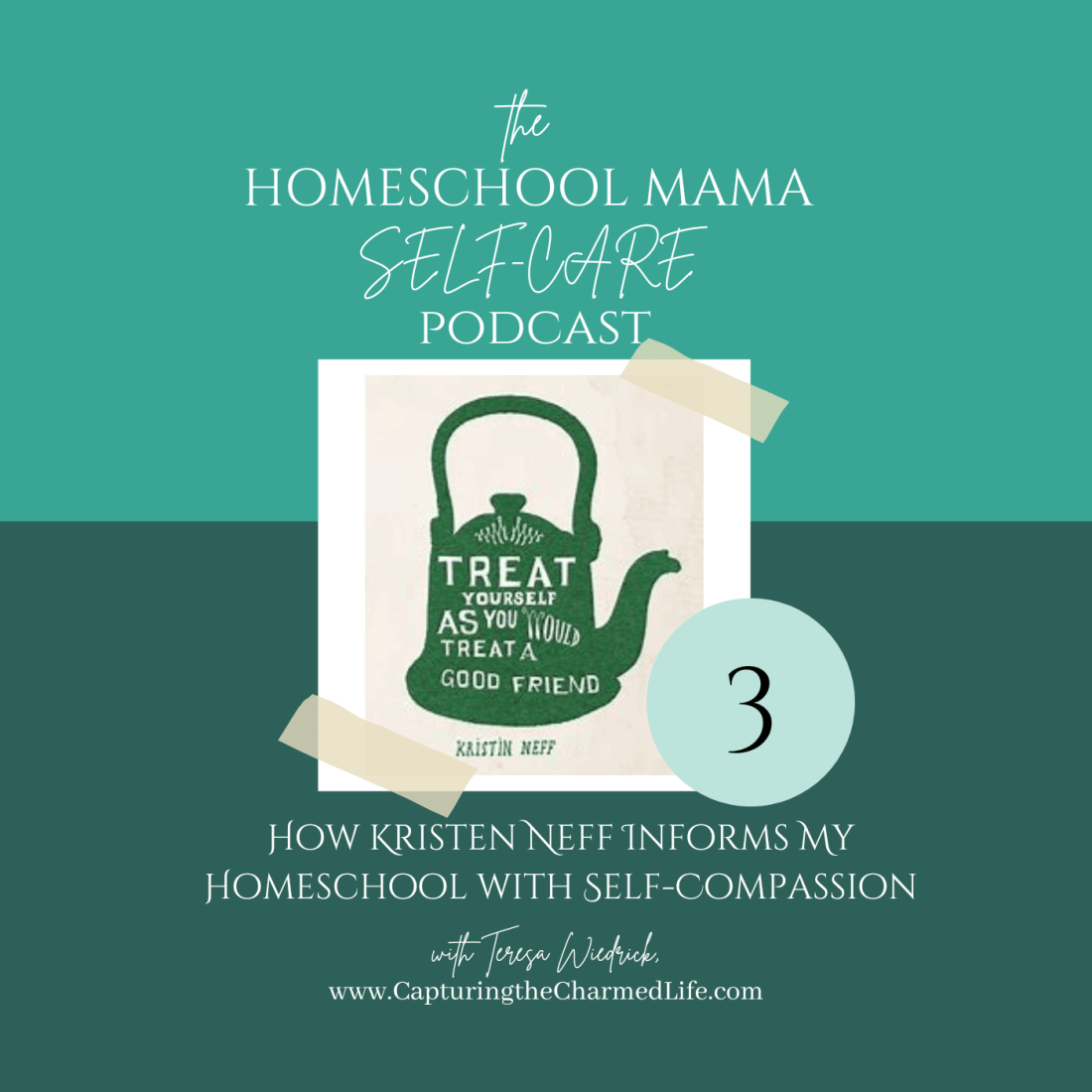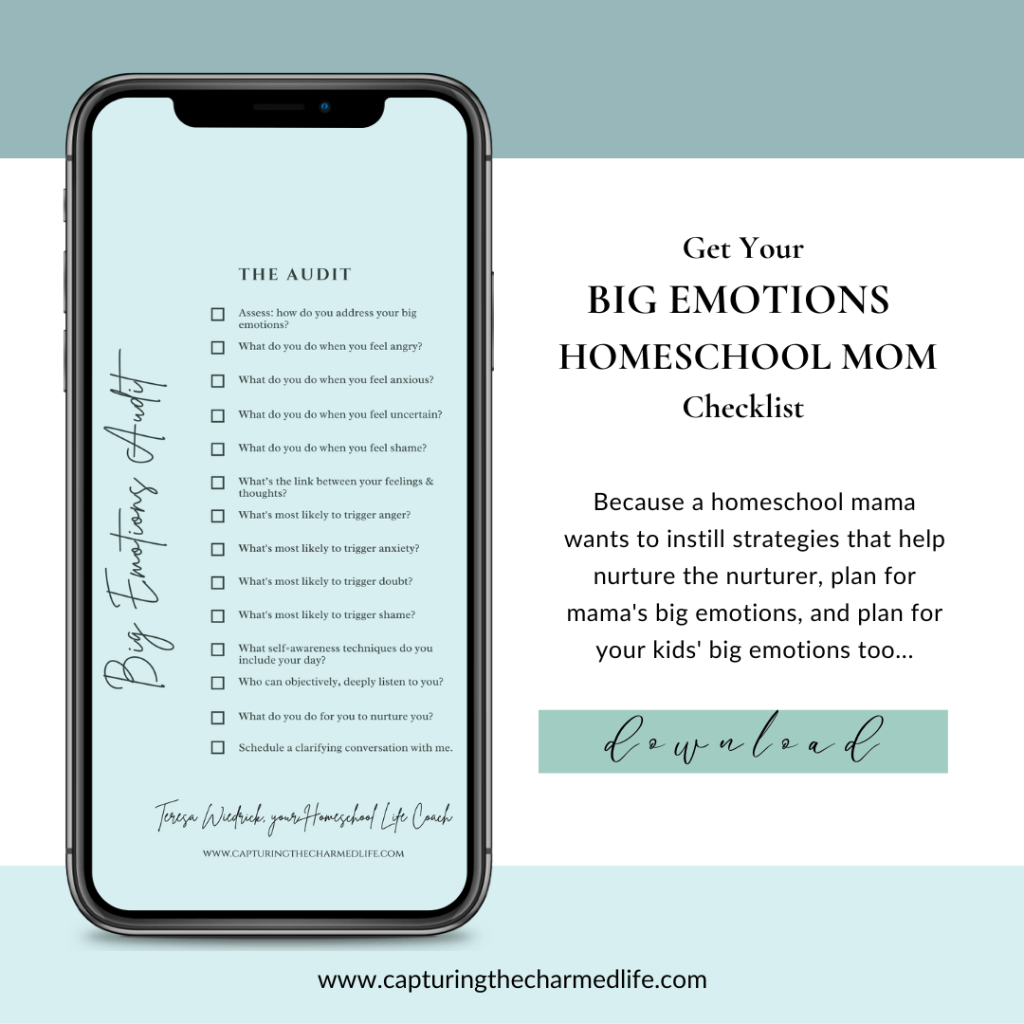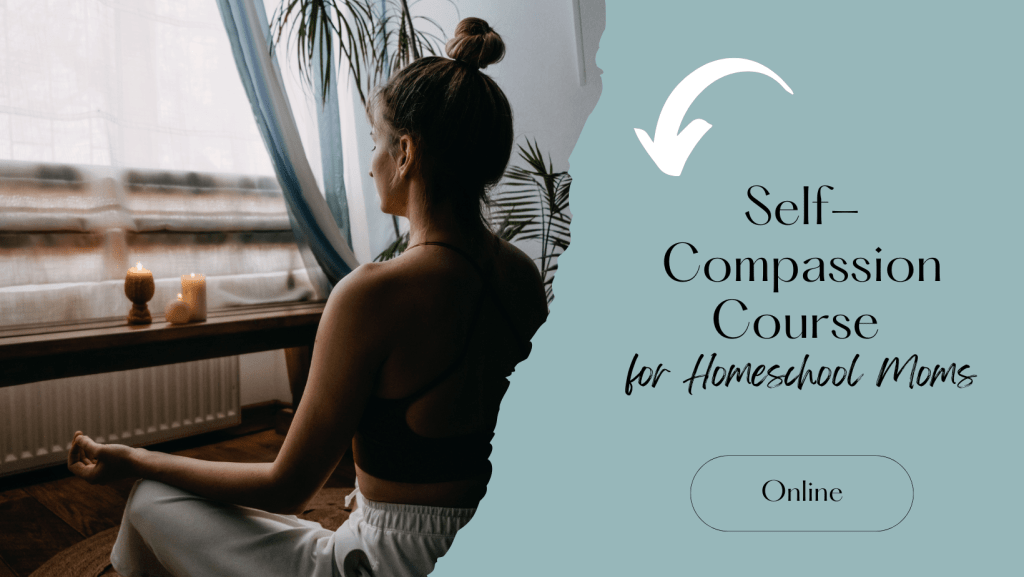Podcast: Play in new window | Download
How does the book, Self-Compassion: The Proven Power of Being Kind to Yourself, inform my homeschool?
Let’s learn from Kristen Neff to learn self-compassion.
Here’s actually how Kristen Neff informs my homeschool as I learn to incorporate self-compassion for homeschool moms.
Straight up, we homeschool mamas need to treat ourselves as kindly as we want to treat our kids. (Cause we can’t practice on our kids what we’re not practicing with ourselves.)
Self-Compassion for homeschool moms in 5 mindsets:
1. Kristen Neff informs my homeschool with this: “With self-compassion, we give ourselves the same kindness and care we’d give to a good friend.”
I often share with homeschool mamas that if they’re particularly heated with their kids, they should head to the bathroom mirror.
Stand in front of the mirror.
See that sad, exasperated, angry face?
What would you say that sad, exasperated, angry face if it were your friend?
So, you might say:
- You look sad. I’m sorry you’re frustrated.
- I care about you. Know that I’m with you.
- I’ve been there, done that. (Even maybe this morning).
- You’re a good mom; I see how you engage most of the time and you care about your kiddo.
What you wouldn’t say is this:
- Girlfriend, you’re a horrible mother.
- Why did you have a child?
- You’re such a screw up.
- When will you ever learn how to parent with kindness/gentleness/self-control/you-fill-in-the-blank?
Nope, words you’d never utter to a friend.
So WHY are you doing that to yourself?
(FYI we all speak more harshly to ourselves than we do to others, but we should practice not doing it.)
How do you want to speak to your friends?
Look back to your face in the mirror: speak to that “friend” in the mirror.
I came by this practice on a day when I couldn’t access my husband by text. (Because I would have waxed and waned, complained and bellyached as though it were therapeutic).
So what did I do?
I tried to text my good friend too.
But she wasn’t available either.
What to do??
Who was I going to talk with?
Myself. In the mirror.
I’ve since discovered that a useful, though odd, approach to calming myself down is talking to me.
And when I’m calm?
I can decide how to intentionally respond to my anger/anxiety/sadness/other intense emotion AND head back to my homeschooled kiddos and engage intentionally.
Self-compassion for the homeschool mama begins with treating ourselves like our own best friend.
2. “The beauty of self-compassion (for homeschool moms) is that instead of replacing negative feelings with positive ones, new positive emotions are generated by embracing the negative ones. Positive emotions of care and connectedness are felt alongside our painful feelings. When we have compassion for ourselves, sunshine and shadow are both experienced simultaneously. This is important to ensure that the fuel of resistance isn’t added to the fire of negativity. It also allows us to celebrate the entire range of human experience, so that we can become whole. As Marcel Proust said, “We are healed from suffering only by experiencing it to the full.”
Girlfriend, this quote might take a bit to reach its depth in all of us.
Say whaaa? We’re supposed to feel our suffering, our pain, our shadow sides?
If you’re reading this far, I’m guessing you’ve decided that challenge or pain or suffering is just part of this life thing.
(Why would I assume that? Because a discussion on self-compassion means you need to have self-compassion for your discomfort/challenge/pain/suffering.)
We’re humans.
Humans have suffering, pain, discomfort, and challenges.
“When we have compassion for ourselves, sunshine and shadow are both experienced simultaneously.”
As we embrace our negative feelings, they feel heard and seen, and honoured.
And that’s all that negative feelings need: an ear, a validation that they exist, an honouring of the person behind those negative feelings.
Accepting negative feelings enables us to be fully human.
We need to accept our humanness.
If there is anything I’ve learned from my own suffering, it is that I can’t pretend the suffering isn’t there.
When I do, I don’t acknowledge my deep needs and I don’t create a construct for addressing that pain.
Addressing those negative feelings isn’t an option. I have to address them all.
And when I do, when I acknowledge them, see them, witness them, they feel seen and heard. This is self-compassion for homeschool mom.
Then I can go on in life.
**Watch Vicki Tillman & I discuss Self-Compassion practices for homeschool mamas.
3. Kristen Neff encourages self-compassion for homeschool moms with this: “When we hold negative thoughts and feelings in nonjudgmental awareness, we are able to pay attention to them without getting stuck like Velcro. Mindfulness allows us to see that our negative thoughts and emotions are just that—thoughts and emotions—not necessarily reality. They are therefore given less weight—they are observed, but not necessarily believed. In this way, negatively biased thoughts and emotions are allowed to arise and pass away without resistance. It allows us to deal with whatever life brings our way with greater equanimity.”
This concept was revolutionary for me personally, and in how I approached my homeschooled kids.
Just because I had a thought or feeling doesn’t mean it’s true.
I remember listening to Dr. Daniel Amen speaking about A.N.T.S. (which he referred to automatic negative thoughts).
We all have negative thoughts.
But we get to decide what to do with them.
Mind blown.
Aren’t my thoughts ME?
No they are not.
Just like clouds in the sky pass through the sky, your thoughts and feelings pass through you too.
Clouds are not sky.
So if that be the case, then WHY do we believe those thoughts and respond and react to them like they are US and we must do something with them?
Not sure.
But I do know how challenging it is to let them go and not allow them to stick like Velcro.
And the magic potion that helps me be anti-Velcro with my thougths?
Meditation and mindfulness.
You don’t have to train to be a Buddhist monk or Yogi to practice meditation and mindfulness.
Simply sit.
Just sit.
Take a deep breath in. Stare at a spot on the wall. Allow yourself to sit there for a moment and focus on that spot.
Okay, another deep breath.
Keep your eyes on that spot. But notice what is in your peripheral vision. The colours, the textures, the objects. But keep your eyes on that spot.
Take another deep breath.
Imagine what might be beyond your peripheral vision (you’ve probably sat in this room before, so you know, but just imagine, don’t look, continue staring at the spot).
Take another deep breath.
Imagine what might be behind you. Do a full 360 view in your mind’s eyes as you continue to stare at that blank spot on the wall.
Take another deep breath.
Okay, how do you feel?
That is a meditative practice (amongst many others).
How do you feel?
You didn’t become a monk. And you weren’t in a trance. You just were.
Present, you were present.
- You were not preoccupied with your other thoughts.
- Not swept away by the dishes undone on the kitchen counter.
- Probably not focused on the next thing you have to do on your checklist.
You practiced presence: a strategy of self-compassion for the homeschool mama.
4. A principle of self-compassion for homeschool moms: “The key to happiness was understanding that suffering is caused by resisting pain.”
Once upon a time, I didn’t want to ever feel pain again.
(This is a true story from my life. Is it the first line of one of your stories too?)
I didn’t like pain because it made me feel scared, insecure, unloved, and uncertain.
As proof to my story, I started a blog called Capturing the Charmed Life (you’re reading it right now).
Why title a website that name?
Because I wanted charms, not challenges.
- I wanted charms, no heartache.
- Perfection was my goal so no bumps along the way.
- I wanted charms, no pain.
By pursuing that charmed life, I ignored the stuff that wasn’t right.
Naturally, I ignored multiple purple elephants in the room, and I tried very hard to pretend I didn’t see them.
- I ignored relationships that weren’t right.
- Certainly, I ignored others’ overstepping my boundaries. Wait, did I even have boundaries?
- Obviously, I ignored my health & wellness.
If I acknowledged them, it would have required I recognized the ramifications of those elephants.
- Ramifications like relationships that needed work; other people had to own their stuff, and so did I.
- Also, I had to develop a separate sense of self so I could even know what my boundaries might be.
- How was I eating, not exercising, not sleeping, not taking time away for myself?
Fast forward almost two decades later, I’ve learned that I had a very good reason to ignore those purple elephants.
- Some of those wanted to sit on me and suppress me if I acknowledged they were there. Which required me to practice some heavy lifting and resist the elephant.
- There were purple elephants that wanted me to simply watch them all day long, but I learned I had other things to do and I didn’t want to spend my life watching them.
- Some of them were of my own making: not taking care of myself.
Subsequently, I’ve learned, there is no way to live a charmed life continuously. Life won’t allow for utopia.
But turn challenges into charms? Oh yeah, girlfriend, I can do that.
I’ve learned I can do that by not resisting pain, and not pretending that purple elephants are dancing in my room.
5. Kristen Neff shares in her book, “Tara Bennett-Goleman uses the metaphor of alchemy to symbolize the spiritual and emotional transformation that’s possible when we embrace our pain with caring concern. When we give ourselves compassion, the tight knot of negative self-judgment starts to dissolve, replaced by a feeling of peaceful, connected acceptance—a sparkling diamond that emerges from the coal.”
What is alchemy?
Paulo Coelho writes in his novel The Alchemist, “Each thing has to transform itself into something better, and acquire a new destiny.”
We are trying to observe our pain, our big emotional reactions, so we can see things as they actually are.
There’s no direct attempt at changing them as we observe and accept them.
We can’t make ourselves not feel our big emotions.
Big emotions are part of being human.
But we can change the way we relate to those big emotions.
We can use mindfulness to become more self-aware and, therefore, create a distance between our big emotions and ourselves.
This is the heart of mindfulness…
In an article by Tara Bennett-Goleman, a psychotherapist and the author of the New York Times bestseller Emotional Alchemy, we are reminded, “The warmth of sunlight dissolving the moisture of clouds—nature’s alchemy—echoes the warm fire of mindfulness melting the emotional clouds uncovering our inner nature. The effects of such periods of insightful clarity may be fleeting and momentary, lasting only until the next emotional cloud forms. But rekindling this awareness again and again—bringing it to bear on these inner clouds, letting it penetrate and dissolve the haze in our minds—is the heart of mindfulness practice, a practice we can learn to sustain.
Tara Bennett-Goleman, author of Emotional Alchemy
When it comes to the turbulent feelings that roil within us, it’s not that we can wrap up our bewildering emotions in neat formulaic explanations, but that we can use an ongoing inquiry to reach small epiphanies, insights that grow one on the other toward greater clarity.
In a sense, our darker moments and most upsetting feelings are an opportunity for spiritual growth and uncovering our natural wisdom, for waking up—if we choose to use them that way.
If so, our deepest insights can emerge from working directly—with awareness—with our own difficulties (a self-compassion for homeschool moms practice).
A strong emotional obsession or pattern is like the scene in “The Wizard of Oz” where Dorothy and her companions finally get to Oz.
The Wizard is this powerful, looming presence that terrifies them—until the little dog, Toto calmly goes over and pulls back the curtain to reveal an old man who stooped over the controls, manipulating a huge wizard image.
Emotional fixations are like that—if you see them, unflinchingly, for what they are, you take the power away from them. They no longer control you.”
Kristen Neff informs my homeschool: You have to allow yourself to feel your feelings and accept your feelings too.
**Learn more about creating mindfulness practices for homeschool moms.
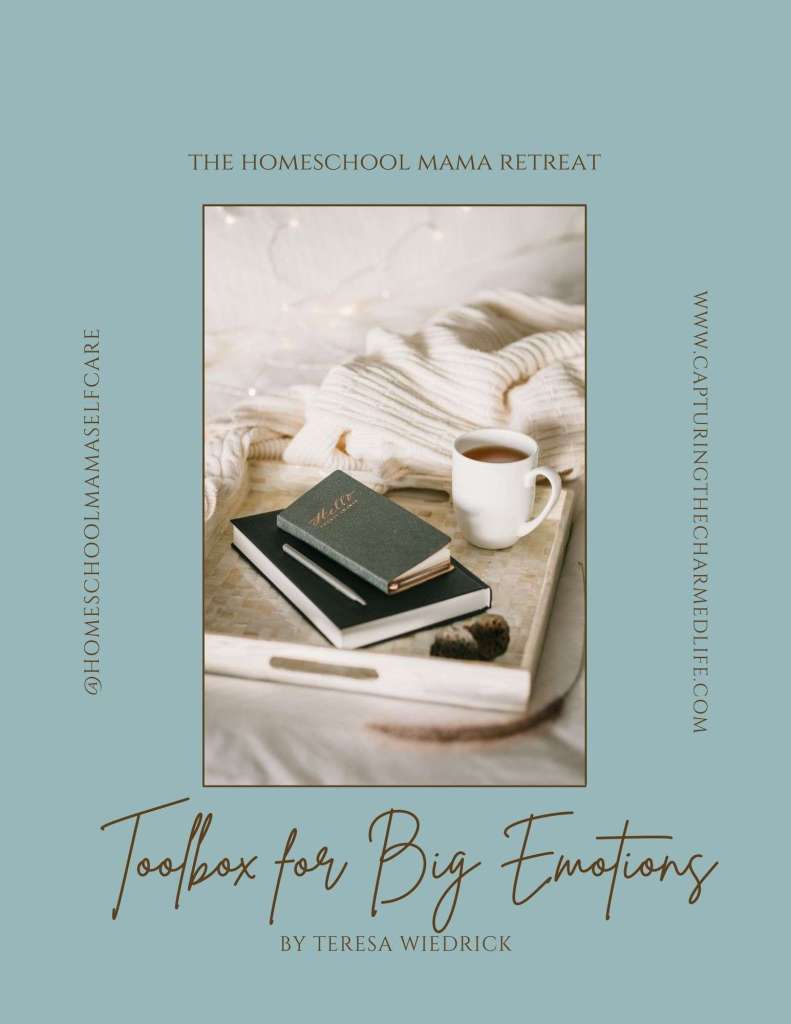
Big Emotions Journal for the Homeschool Mom
Introducing the Homeschool Mama’s Toolbox, a resource to help homeschooling mothers manage emotions and enhance mindfulness. It includes Dr. Amen’s three questions for self-reflection. Daily meditation practices and a Thought Care Checklist aid in handling challenging situations. Sharpen your mental tools and improve your homeschooling journey today!
Homeschool Mama Book Club
…how our favourite authors inform our homeschools…
Join monthly to engage in book club discussions from important influencers that can shift how we show up in our homeschools & lives.
Read the book in advance, or don’t.
And engage in authentic, vulnerable conversations that provide community & connection too.
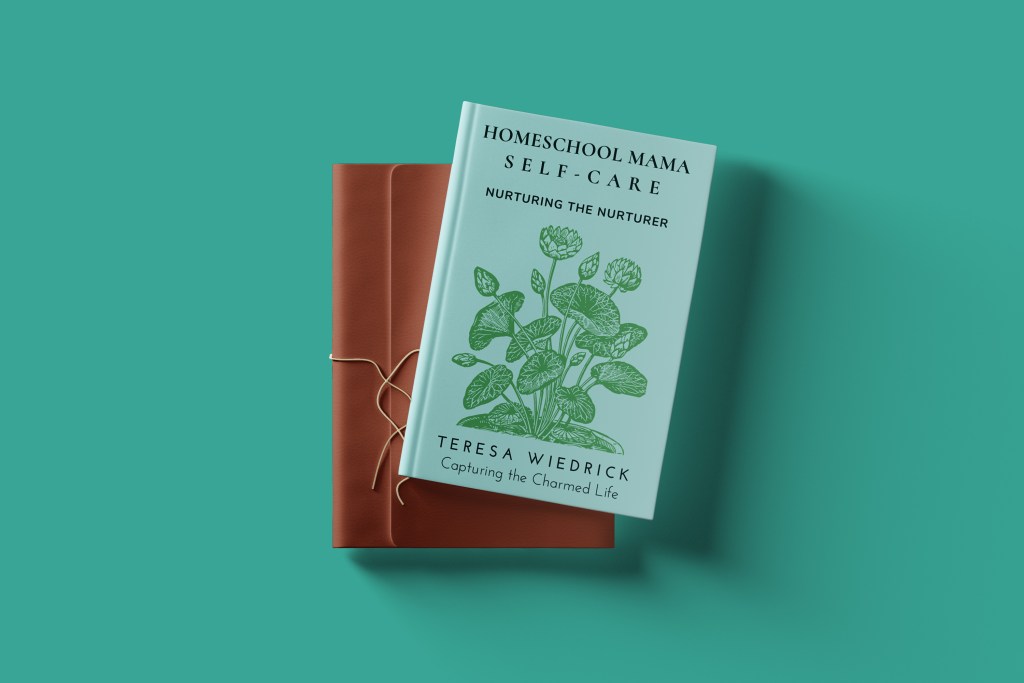
Homeschool Mama Self-Care: Nurturing the Nurturer
“My homeschooling journey has included a growing pile of books that I have read, browsed, or barely got past the first chapter. This book is just delightful and a gem! It’s not only helpful and inspiring but also funny. The author is like that no-nonsense brave friend who is looking out for you and your well-being as a homeschooling mama. We all need that friend and I am taking my time as I work my way through the chapters and enjoying it all. I love the section on overcoming overwhelm, grappling with perfectionism, and minding and working through our emotions. This book is worth its weight in gold. Find a quiet place to read, bring a warm cup of tea, and enjoy!”
–Sonia in S. Jersey
Frequently Asked Questions
When will I see the Book Club Zoom link in my email?
You’ll see the zoom link in your email the morning of your Book Club. Make sure your email provider hasn’t thrown it into Junk Mail.
Where can I purchase the book?
You can find all the books from our Book Club in the Capturing the Charmed Life Amazon Book Shop. When you purchase here, you support me!
Does this Book Club cost?
The nominal $5 purchase enables the Zoom group platform. Oh, and time, it costs you time. You’ll have to find a quiet hour and a half away from the kids and responsibilities to spend time on YOU!
How long is the Book Club?
Usually about an hour and a half.
Can I ask questions about the book and its applications to my homeschool?
Absolutely! I’ll share my insights from the book and how they apply to our homeschools, but the best part of this book club? You sharing your thoughts and how it applies to your homeschool. If you have thoughts, insights, or questions, we want to hear them.
People also ask:
- Where do I sign up for the Homeschool Mama Book Club?
- Tell me where to find your Homeschool Mama Reading List.
- Free (&/or Affordable) Homeschool Coaching Options for You!
- Self-Compassion for the Homeschool Mama: How to Teach it to Yourself
- How to deal with unrealistic expectations in your homeschool.
- Tell me more about your homeschool mama retreat.
- I’m a new homeschooler, are you able to walk alongside and mentor me?
Call to Adventure by Kevin MacLeod
Link: https://incompetech.filmmusic.io/song/3470-call-to-adventure
License: http://creativecommons.org/licenses/by/4.0/
